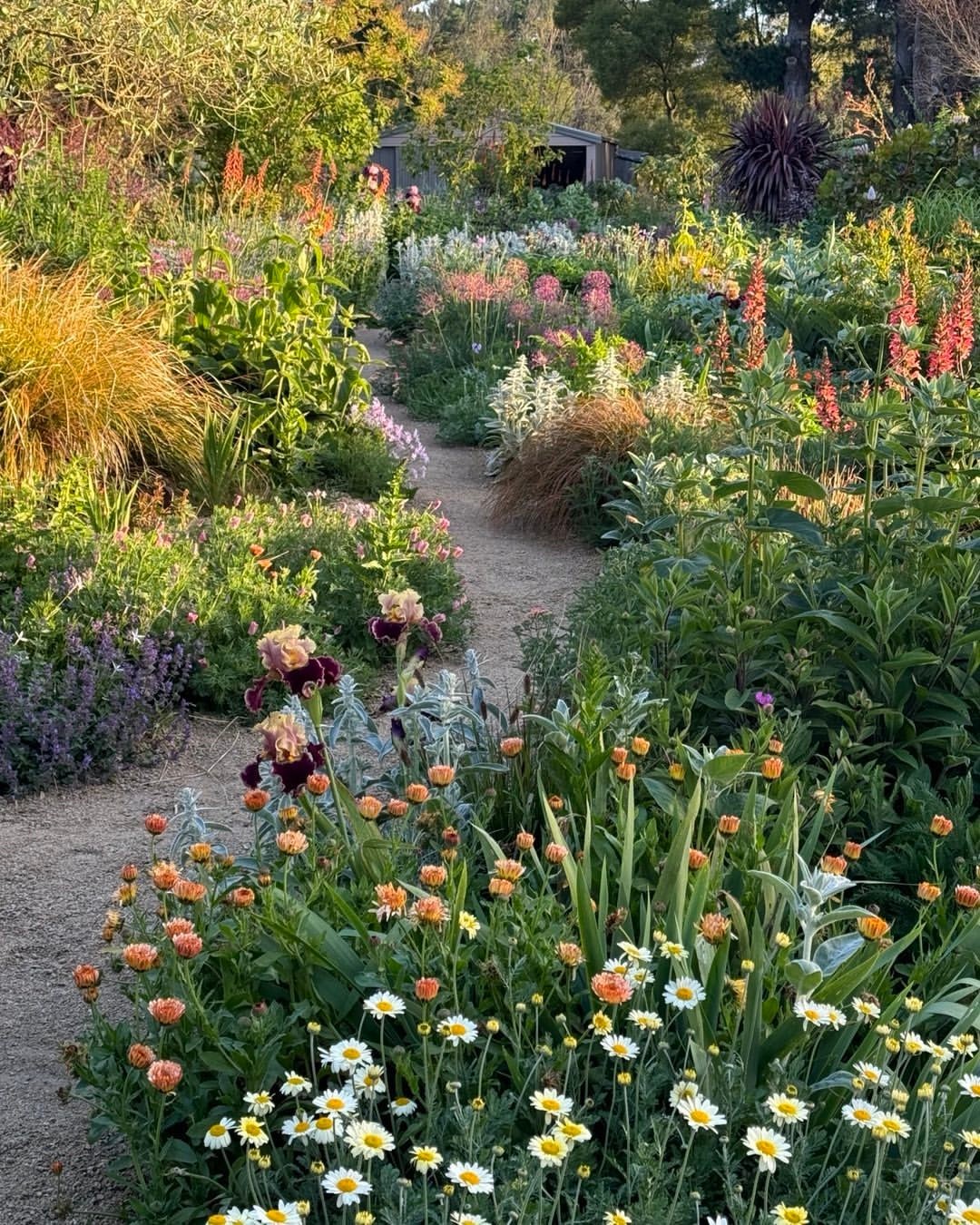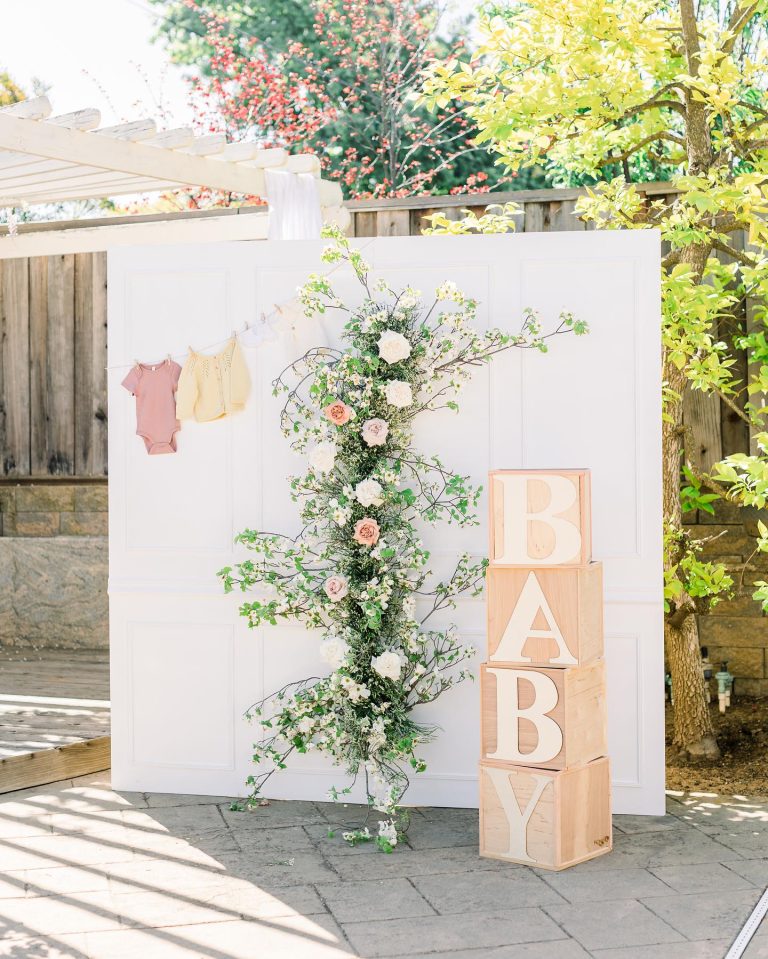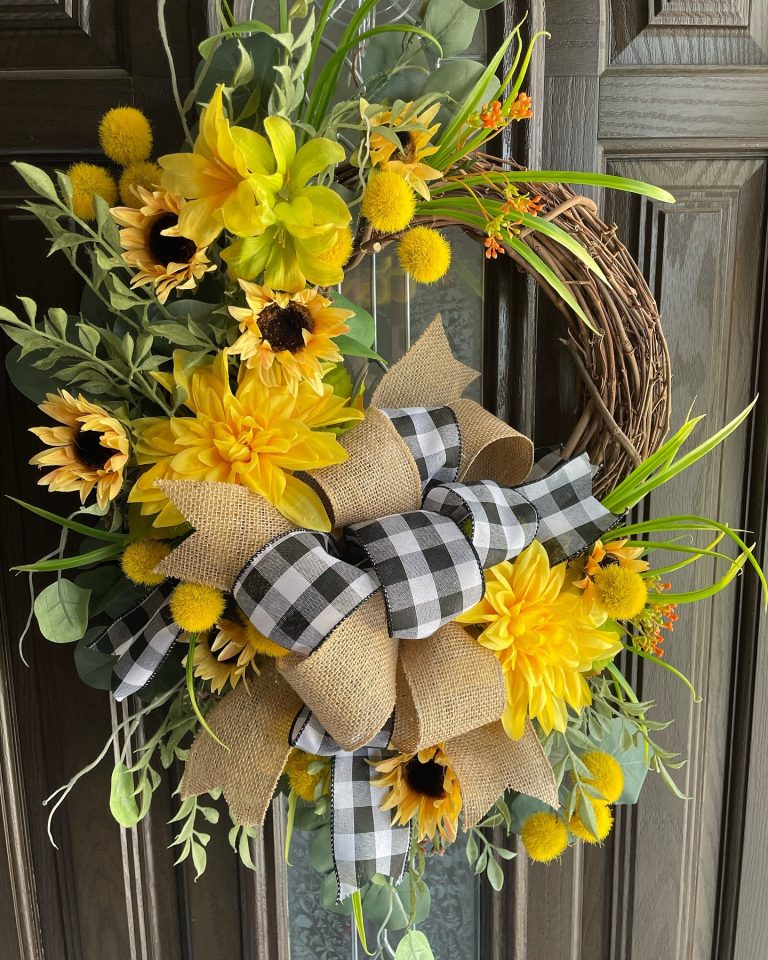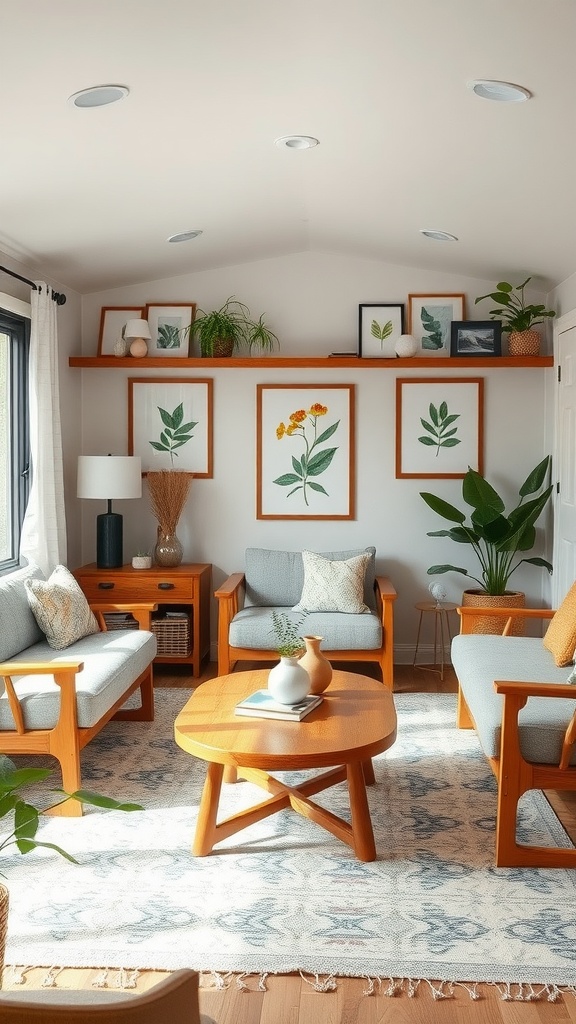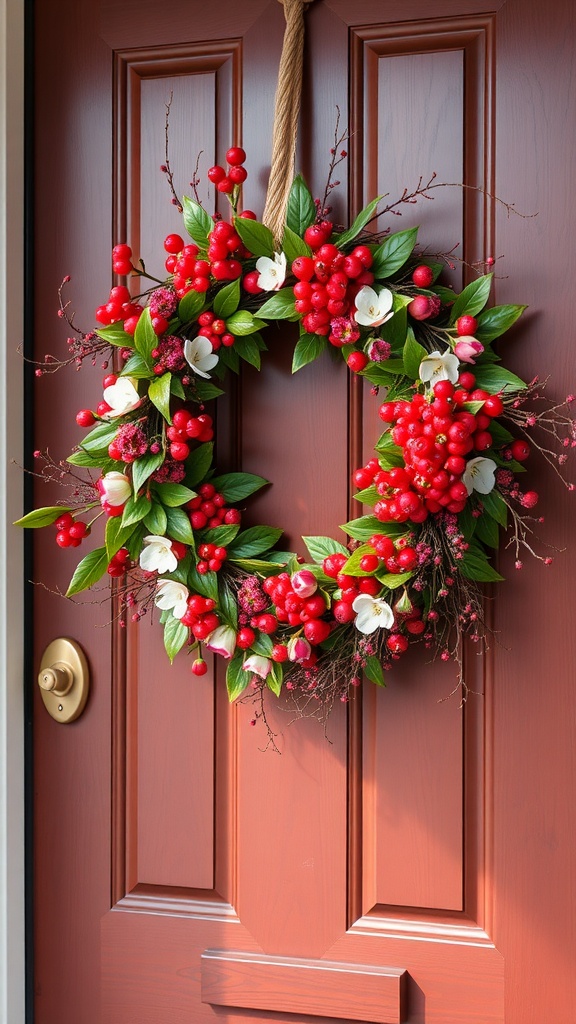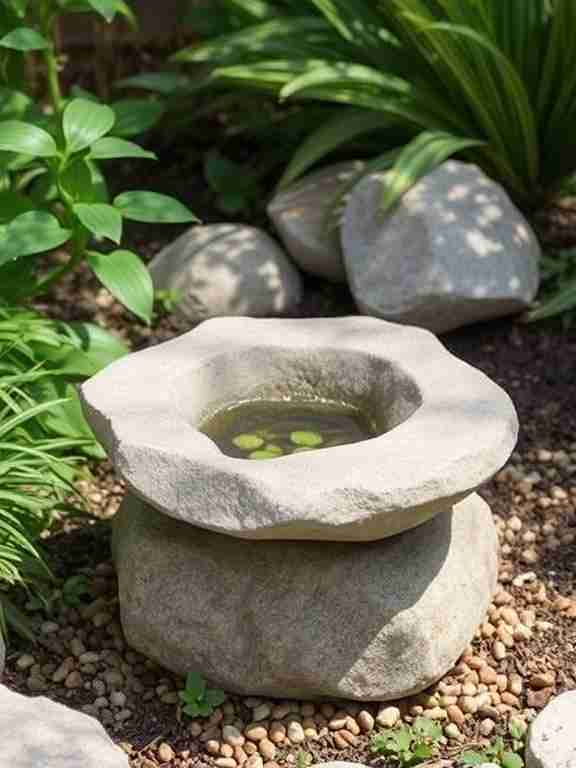13 Swale Landscaping Ideas to Inspire Your Outdoor Oasis
Swales are a perfect combination of practicality and beauty in landscaping. They’re designed to control water flow, prevent erosion, and manage stormwater runoff. However, with the right design, a swale can also become a stunning focal point in your garden or backyard. Whether you’re looking to add color, texture, or functionality to your yard, these 13 swale landscaping ideas will inspire you to create an outdoor space that’s both beautiful and sustainable.
1. Natural Stone Swales for Rustic Charm
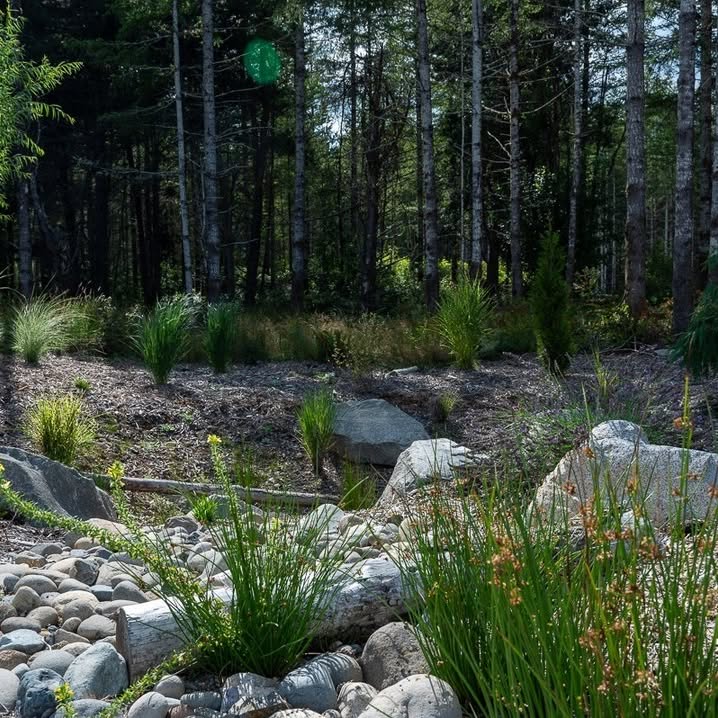
Source: Natural stone swales can turn an ordinary yard into a serene, rustic paradise.
If you’re someone who loves the natural look, incorporating stone into your swale design is a fantastic option. River rocks, boulders, and even decorative stone borders can create a stunning yet functional feature in your landscape. The natural color variations of stones bring texture and depth to the swale, creating a more organic, rustic feel that’s perfect for country-style or natural garden aesthetics.
These stones help with water filtration as they allow for better water absorption, reducing runoff and preventing erosion. Plus, they make an attractive border or edge, seamlessly blending your swale with the rest of your landscaping.
Another benefit of using natural stone is its low maintenance. The rocks won’t need to be replaced or replanted, and over time, the stone can weather beautifully, adding more character to your garden. Pairing your stone swale with hardy plants like ornamental grasses, sedges, or even moss will complete the look.
If you have a larger yard or are working on a sloped landscape, natural stone swales are ideal for creating cascading effects and maintaining a harmonious, earthy vibe.
2. Rain Garden Swale Combo

Source: Rain gardens are an excellent way to manage stormwater while adding beauty to your yard.
Imagine a swale that does more than just manage water. By turning your swale into a rain garden, you can attract wildlife, help the environment, and add seasonal beauty to your yard. A rain garden is specifically designed to handle stormwater runoff, but when combined with a swale, it creates a beautiful garden feature that absorbs water and reduces flooding.
To create a rain garden within your swale, you’ll need to choose plants that thrive in both wet and dry conditions. Native plants are particularly beneficial, as they are well-adapted to local conditions and often require less maintenance. Look for plants like lavender, black-eyed Susans, and bluebells for vibrant color and texture.
Rain gardens also provide a valuable habitat for pollinators, birds, and other beneficial wildlife. Not only do they help absorb rainwater, but they also contribute to the local ecosystem. A swale and rain garden combo is perfect for environmentally-conscious homeowners looking to add a beautiful, sustainable feature to their yard.
3. Dry Creek Bed Lookalike
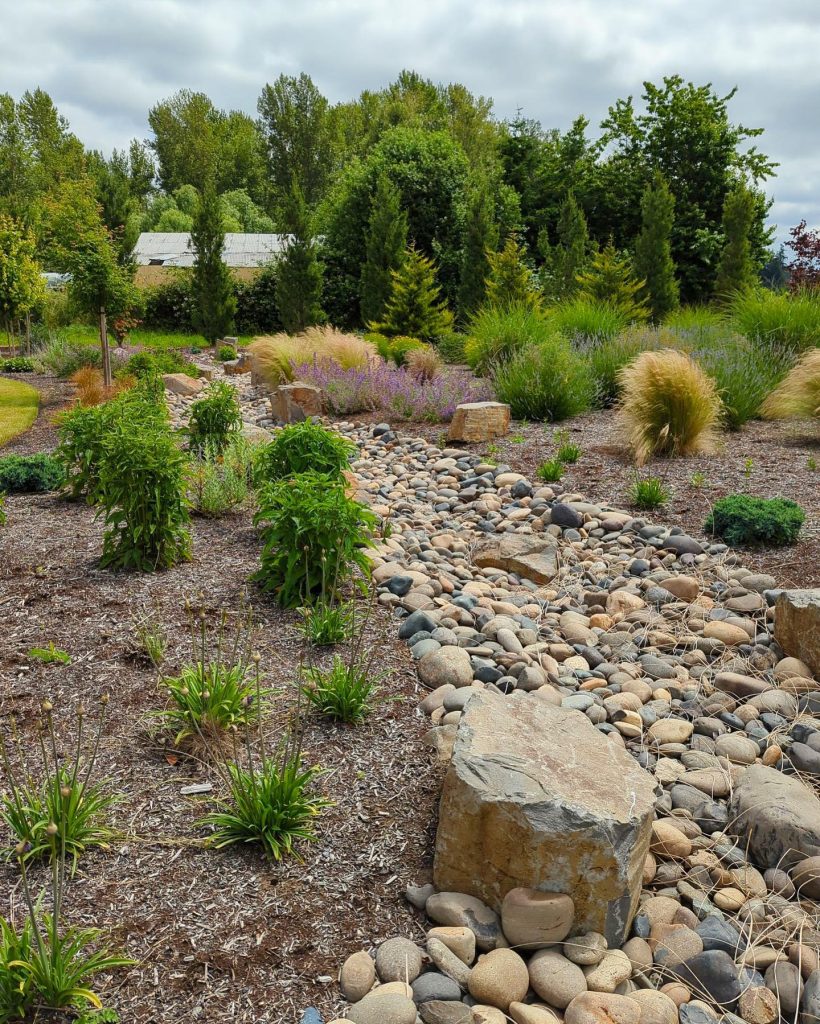
Source: A dry creek bed swale adds a calming, natural feel to your landscape.
If you love the peaceful sound of flowing water but don’t want the maintenance of a full-fledged pond or stream, a dry creek bed swale is a beautiful alternative. This type of swale mimics the look of a creek without the need for constant water flow. It uses rocks, gravel, and pebbles to create the illusion of a dry stream running through your yard, which is perfect for areas that don’t experience consistent rainfall.
The key to creating a dry creek bed look is selecting rocks and stones that vary in size and shape. Arrange them in a meandering, natural pattern to replicate the look of a stream. Incorporating plants that can tolerate both dry and wet conditions will add even more life and interest to the swale. Try planting ferns, sedges, or low-maintenance wildflowers along the edges to enhance the natural appearance.
This type of swale is also highly functional, as it directs water away from vulnerable areas while adding a calming visual element to your garden. If you’re looking to add some texture and movement to your landscape without a full water feature, a dry creek bed swale is a great choice.
4. Lush, Layered Planting for Color and Texture
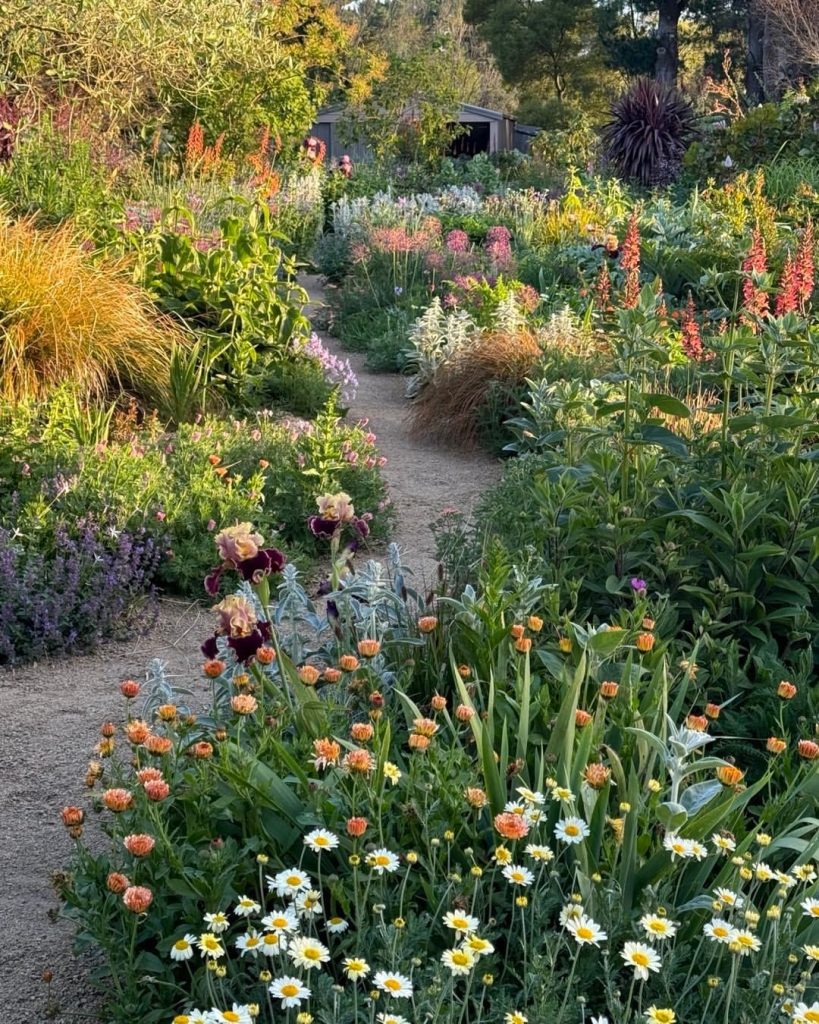
Source: Layered planting creates depth and interest in your swale, making it a visual delight year-round.
One of the most exciting aspects of designing a swale is the potential for beautiful plantings. When you add layered plantings, you create a dynamic, multi-dimensional look that changes with the seasons. By planting in layers, you can create visual depth, texture, and color in your swale that lasts all year long.
Start with taller plants at the back of your swale, such as ornamental grasses or native shrubs. These plants can help fill the space and add vertical interest. In the middle, plant medium-height perennials like coneflowers or bee balm that thrive in moist conditions. Finally, ground covers and smaller plants like creeping thyme or sedum can be planted along the edges for a low-maintenance, colorful touch.
The best part? These layered plantings are great for attracting pollinators like bees and butterflies, making your swale not only beautiful but eco-friendly as well. Choose plants that can tolerate occasional flooding and drying to ensure that your swale remains healthy and vibrant throughout the year.
5. Stepping Stones or a Garden Path
Source: Add functionality and charm by incorporating stepping stones into your swale design.
Stepping stones are a fantastic way to add both function and visual interest to your swale. Not only do they allow you to easily navigate the swale without damaging the plants or causing erosion, but they also create a charming path that invites you to explore the space.
Stepping stones can be made from a variety of materials—natural stone, concrete, or even reclaimed wood—and placed strategically to lead through or along the swale. You can design the path to follow the natural curves of the swale, which helps maintain the aesthetic flow of the landscape.
In addition to being practical, stepping stones add a touch of whimsy and elegance to the swale. For a modern, clean look, opt for rectangular or square stone shapes. If you prefer something more natural, round stones or flagstones might be more your style. As a bonus, you can plant creeping thyme or moss between the stones to soften the look and add extra texture.
6. Edible Swales with Herbs and Berries
Source: Swales don’t just need to be ornamental—make yours productive with edible plants like herbs and berries.
Swales are ideal for growing plants that need consistent moisture, making them perfect for herbs, vegetables, and even fruit-bearing plants. An edible swale combines function with beauty, allowing you to grow delicious, fresh produce right in your yard while also controlling stormwater runoff.
Start by planting moisture-loving herbs like mint, basil, or oregano, which thrive in a swale environment. You can also plant berry bushes like blueberries, raspberries, or strawberries. These plants are not only functional—they also add vibrant color and texture to your landscape.
In addition to herbs and berries, consider planting perennial vegetables like asparagus or rhubarb, which can thrive in the moist conditions of a swale. These edibles will provide you with fresh ingredients for cooking while also enhancing the look and functionality of your landscape. A well-maintained edible swale can give your backyard a unique, sustainable feel, and it’s a perfect project for those who enjoy spending time in the garden.
7. Swales with Sculptural Grasses
Source: Ornamental grasses are a great way to add movement and texture to your swale while requiring minimal maintenance.
Ornamental grasses are a stunning addition to any swale. Their unique textures and graceful movement in the wind can create a calming, almost ethereal atmosphere in your backyard. Whether you prefer tall, dramatic grasses or more subtle, low-growing varieties, ornamental grasses can be a perfect fit for swale landscaping.
Some popular options for swales include blue fescue, switchgrass, and feather reed grass. These varieties are hardy and can tolerate the fluctuating moisture levels that come with a swale. Their striking shapes and textures create a visually interesting landscape, especially when paired with other plants or stone elements.
The beauty of ornamental grasses is their ability to grow with little maintenance. Once established, they don’t require much attention, making them a great choice for homeowners who want to create a beautiful, low-maintenance landscape. The grasses also help with soil stabilization and can reduce erosion in your swale.
8. Wood Mulch for a Natural Finish
Source: Mulching your swale with wood chips or bark creates a soft, natural look while also supporting soil health.
Wood mulch is one of the simplest, most effective ways to finish off a swale. When used as a top layer, mulch helps retain moisture, suppresses weeds, and stabilizes the soil—all of which are essential in a swale environment. The organic matter from the mulch also breaks down over time, enriching the soil and promoting healthy plant growth.
For a natural, rustic aesthetic, consider using bark mulch, wood chips, or shredded leaves. These materials blend effortlessly with the earthy tones of a swale and create a cohesive, harmonious look. If you’re looking to add a touch of refinement, opt for a fine, dark mulch that contrasts nicely with the green of your plants.
In addition to its practical benefits, wood mulch enhances the texture and depth of your swale, giving it a more polished appearance. For an eco-friendly twist, choose mulch from sustainable sources or use reclaimed materials like shredded wood from your own yard cleanup.
Mulching your swale also reduces water runoff, which is a key consideration in areas prone to erosion or heavy rain. By creating a thick layer of mulch, you’ll help your swale maintain its shape and beauty for years to come.
9. Tiered Swales for Sloped Yards
Source: Multi-level swales add visual interest while managing water flow on sloped terrains.
If you live on a property with a slope, tiered swales are a great way to manage water flow while adding architectural appeal. Instead of a simple, single-channel swale, tiered swales involve creating multiple levels or terraces along the hillside. Each tier catches and redirects rainwater, preventing erosion and controlling runoff in a beautiful, structured way.
To create tiered swales, start by building small, gently sloping ridges along the contours of your yard. You can use natural stone, brick, or other materials to create these terraces. Each level of the swale should be designed to handle water flow from the one above, allowing the rainwater to be absorbed gradually and preventing flooding.
Planting on each level of the swale adds even more visual interest. The bottom tier can be planted with moisture-loving plants like ferns or marsh grasses, while the upper tiers can hold hardier, drought-tolerant plants. Layering different types of plants at varying heights creates a lush, dynamic landscape that’s not only visually stunning but also functional in managing stormwater.
This design works especially well in larger yards or properties with significant slopes, as it transforms the natural topography into a dramatic focal point. Plus, tiered swales can enhance the overall flow of your yard, guiding visitors through your garden in a way that’s both purposeful and scenic.
10. Lighting Accents for Evening Ambiance
Source: Add solar or low-voltage lighting to your swale to create a magical atmosphere after dark.
While swales are often thought of as daytime features, lighting can dramatically enhance their beauty when the sun sets. Whether you’re hosting an evening gathering or simply want to enjoy your landscape after dark, strategically placed lighting will highlight the natural features of your swale and create a welcoming, cozy atmosphere.
Solar lights are a great, eco-friendly option for lighting your swale, especially if you want a low-maintenance, cost-effective solution. These lights don’t require wiring and charge during the day, turning on automatically at night. Place them along the edges of the swale or around key features like rocks, plants, or stepping stones.
For a more dramatic effect, try low-voltage uplights or spotlights to highlight taller plants or trees within the swale. You can also use string lights or lanterns to create a soft, whimsical glow, perfect for creating a relaxing outdoor retreat. Whether you prefer a warm, golden light or a cool, bluish tone, the right lighting can completely transform your swale into a stunning nighttime landscape.
Lighting not only enhances the beauty of your swale, but it also adds an extra layer of safety by illuminating pathways or slippery areas. In addition, it makes your outdoor living space more functional, allowing you to enjoy your yard well into the evening.
11. Pond-Inspired Swales with Mini Bridges
Source: Create a tranquil water garden feel by adding a small pond feature and bridge to your swale.
For those who adore the peaceful ambiance of a water garden but don’t have space for a large pond, consider creating a pond-inspired swale. This design integrates a small pond or water feature into your swale, turning it into a calming, reflective space. A small stream, waterfall, or even a gently flowing section of water within the swale can evoke the serenity of a natural waterway.
To enhance the charm of this design, add a mini wooden bridge over the water section of the swale. This creates a picturesque focal point and allows you to cross the swale without disrupting the natural flow of water. A bridge also adds a touch of elegance to your yard, perfect for those looking for a whimsical, nature-inspired garden.
The plants around the pond-inspired swale can include aquatic species like water lilies, lotuses, or bog plants, alongside moist-loving plants like ferns or irises. The reflective surface of the water will also mirror the plants and sky, adding a dynamic element to the landscape that changes with the seasons.
Incorporating a small pond or stream into your swale is ideal for creating a peaceful retreat in your backyard. Whether you’re looking to relax or entertain, the addition of water will bring both beauty and tranquility to your outdoor space.
12. Zen-Inspired Gravel Swales
Source: A minimalist gravel swale creates a calm, zen-like atmosphere in your yard.
For those who appreciate simplicity and tranquility, a Zen-inspired gravel swale offers a peaceful, meditative space in your garden. This design focuses on minimalism, using gravel or small pebbles to form a dry creek bed-like appearance, while strategically placed stones or rocks provide structure.
The gravel helps prevent soil erosion and absorbs rainwater efficiently, just like other swale designs, but its aesthetic is quieter and more refined. For a Zen garden feel, focus on clean lines and geometric shapes, perhaps with a few carefully placed rocks or sculptures to anchor the design. You can also add small water features, like a bamboo fountain or a stone bowl with running water, to introduce a soothing element of sound.
The plants in a Zen-inspired swale are typically low-maintenance and understated, with options like moss, succulents, or ornamental grasses. These plants should create a soft contrast to the stark beauty of the gravel and stone, adding just the right touch of green without overpowering the simplicity of the design.
A Zen gravel swale brings peace and serenity to any outdoor space, making it ideal for a meditation garden, a space for reflection, or simply a calming retreat from the stresses of daily life.
13. Wildlife-Friendly Swales
Source: Design a swale to attract wildlife, creating an eco-friendly oasis in your yard.
If you’re a nature lover, designing a wildlife-friendly swale can help you create a sanctuary for birds, butterflies, and other beneficial creatures. By selecting plants that provide food, shelter, and nesting sites, you can transform your swale into an inviting habitat for local wildlife.
Start by choosing plants that are native to your area, as they’ll naturally attract local pollinators and birds. Consider adding native shrubs, flowering plants, and trees that produce berries or seeds. Plants like milkweed, echinacea, and black-eyed Susans are particularly beneficial for attracting butterflies and bees.
You can also incorporate elements like birdbaths, small logs, or piles of rocks to offer shelter for wildlife. Providing a water source—whether a small pond, birdbath, or rain-catching container—gives creatures a place to drink, bathe, and cool off, especially in dry conditions.
By creating a swale that serves as both a functional drainage solution and a wildlife haven, you’ll not only help the environment but also enjoy watching the beauty of nature right in your own backyard.
Conclusion
Swales aren’t just about managing water—they’re an opportunity to transform your landscape into a functional, beautiful outdoor space. Whether you choose to incorporate natural stone, create a rain garden, or add a pond-inspired feature, each swale design offers unique benefits that go beyond aesthetics. These 13 swale landscaping ideas can turn any yard into a sustainable, vibrant oasis that adds value, charm, and practicality.
The best part? Swales help manage water flow, reduce erosion, and promote healthier gardens—all while giving your landscape a striking, eco-friendly twist. Whether you have a small garden or a large property, there’s a swale design that will complement your space and lifestyle. Happy landscaping!

